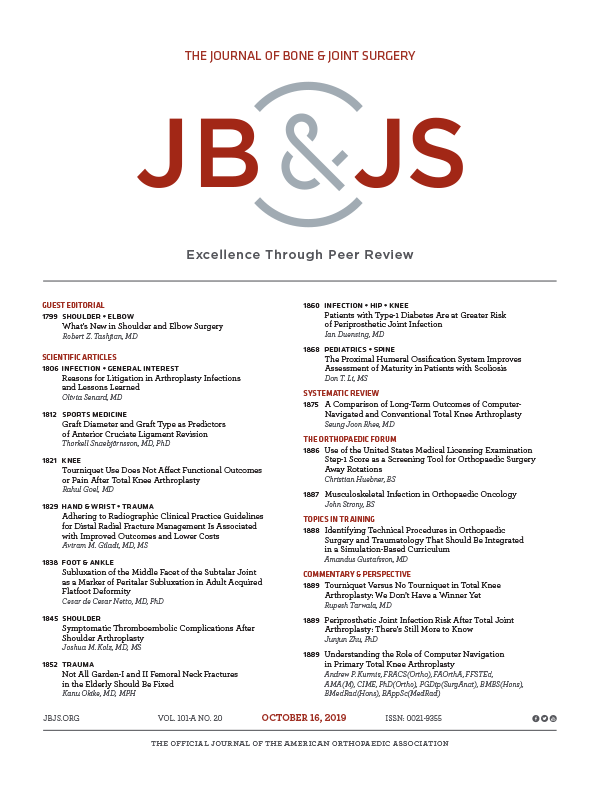
Circular fixator application for bicondylar tibial plateau fractures reduces hospital stay

Circular fixator application for bicondylar tibial plateau fractures reduces hospital stay
Open Reduction and Internal Fixation Compared with Circular Fixator Application for Bicondylar Tibial Plateau Fractures
J Bone Joint Surg Am. 2006 Dec;88(12):2613-23.Synopsis
82 patients with 83 displaced bicondylar tibial plateau fractures were randomized to receive standard open reduction and internal fixation with medial and lateral plates or percutaneous and/or limited open fixation and application of a circular fixator. At the 2 year follow-up there was no significant difference in clinical outcomes between the open reduction group and circular fixator group, however, a marginally faster return to function was observed at 6 months in the circular fixator group. Additionally, patients in the circular fixator group required a significantly shorter hospital stay than the patients in the internal fixation group, and the open reduction and internal fixation group exhibited significantly more complications.
Was the allocation sequence adequately generated?
Was allocation adequately concealed?
Blinding Treatment Providers: Was knowledge of the allocated interventions adequately prevented?
Blinding Outcome Assessors: Was knowledge of the allocated interventions adequately prevented?
Blinding Patients: Was knowledge of the allocated interventions adequately prevented?
Was loss to follow-up (missing outcome data) infrequent?
Are reports of the study free of suggestion of selective outcome reporting?
Were outcomes objective, patient-important and assessed in a manner to limit bias (ie. duplicate assessors, Independent assessors)?
Was the sample size sufficiently large to assure a balance of prognosis and sufficiently large number of outcome events?
Was investigator expertise/experience with both treatment and control techniques likely the same (ie.were criteria for surgeon participation/expertise provided)?
Yes = 1
Uncertain = 0.5
Not Relevant = 0
No = 0
The Reporting Criteria Assessment evaluates the transparency with which authors report the methodological and trial characteristics of the trial within the publication. The assessment is divided into five categories which are presented below.
2/4
Randomization
2/4
Outcome Measurements
4/4
Inclusion / Exclusion
4/4
Therapy Description
4/4
Statistics
Detsky AS, Naylor CD, O'Rourke K, McGeer AJ, L'Abbé KA. J Clin Epidemiol. 1992;45:255-65
The Fragility Index is a tool that aids in the interpretation of significant findings, providing a measure of strength for a result. The Fragility Index represents the number of consecutive events that need to be added to a dichotomous outcome to make the finding no longer significant. A small number represents a weaker finding and a large number represents a stronger finding.
Why was this study needed now?
Open reduction and internal fixation (ORIF) of bicondylar fractures of the tibial plateau is the current gold standard for treatment. However, damage caused by the original injury and the surgical procedure can lead to a high rate of complication. Alternative methods of treating bicondylar fractures of the tibial plateau have become increasingly common due to negative effects of complications associated with ORIF. One of these alternative treatments is circular frame fixation with or without percutaneous lag-screw fixation. This study aimed to determine whether percutaneous and/or limited open fixation and application of a circular fixator provides better fracture reduction quality than standard open reduction and internal fixation with medial and lateral plates.
What was the principal research question?
Does percutaneous and/or limited open fixation and application of a circular fixator improve clinical outcomes of patients with displaced bicondylar tibial plateau fractures when compared to open reduction and internal fixation with medial and lateral plates 2 years after surgery?
What were the important findings?
- At 6 months, the HSS knee score was 72 for the circular fixator group and 61 for the open reduction group (p=0.064). At 1 year the HSS knee score was 72 for the circular fixator group and 67 for the open reduction group (p=0.406). At 2 years, the HSS knee score was 75 for the circular fixator group and 68 for the open reduction group, which was found to be not statistically significant (p=0.307).
- The difference in mean pain, stiffness, or function on the WOMAC score between the circular fixator group and open reduction group at 6 months, 1 year, and 2 years was found to be not clinically significant (p>0.05), and no difference in total arc of knee motion was apparent (p>0.05).
- Both the circular fixator group and open reduction group achieved significantly lower mean WOMAC scores at the 2 year follow-up relative to preoperative scores (p<0.05).
- The difference between preoperative and 2 year follow-up SF-36 scores were found to be clinically significant for both the circular fixator group (p=0.001) and the open reduction group (p=0.014). At the 2 year follow-up, the difference between the circular fixator group and open reduction group was not significant for all SF-36 domains except for the bodily pain domain, which was significantly better for the circular fixator group (p=0.041).
- The circular fixation group required a significantly shorter hospital stay (9.9 days) than the open fixation group (23.4 days) (p=0.024) along with significantly less Intraoperative blood loss (213 mL vs. 544 mL respectively; p= 0.006).
- The quality of osseous reduction was similar between groups. Patient ability to return to preinjury activities at 6 months and 12 months was superior in the circular fixation group compared to the ORIF groups (p=0.031 and p=0.024 respectively) but not at 2 years.
- 7 (18%) ORIF patients reported a deep infection. The number of unplanned repeat surgical interventions, along with their severity, was greater in the ORIF group (37 procedures) compared with the circular fixator group (16 procedures) (p= 0.001).
What should I remember most?
The data suggested that percutaneous and/or limited open fixation and application of a circular fixator did not significantly improve clinical outcomes of the knee but significantly reduced the required hospital stay when compared to standard open reduction and internal fixation with medial and lateral plates. Complications were also significantly more incident in the open reduction and internal fixation group.
How will this affect the care of my patients?
The study suggests that percutaneous and/or limited open fixation and application of a circular fixator may not significantly improve clinical outcomes when compared to standard open reduction and internal fixation with medial and lateral plates over a 2 year follow-up period. Further research using larger sample sizes are required to confirm the findings of this study.
Learn about our AI Driven
High Impact Search Feature
Our AI driven High Impact metric calculates the impact an article will have by considering both the publishing journal and the content of the article itself. Built using the latest advances in natural language processing, OE High Impact predicts an article’s future number of citations better than impact factor alone.
Continue



 LOGIN
LOGIN

Join the Conversation
Please Login or Join to leave comments.